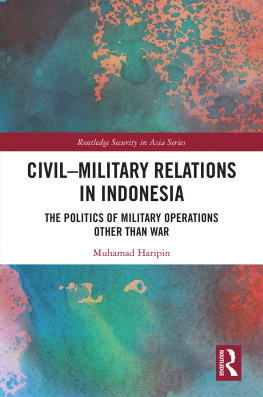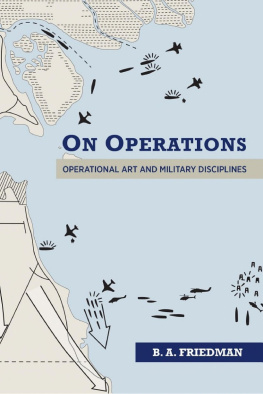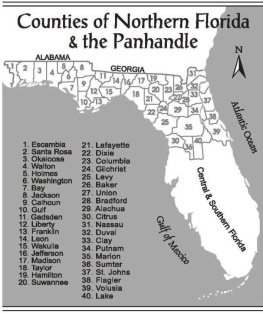
This edition is published by PICKLE PARTNERS PUBLISHINGwww.picklepartnerspublishing.com
To join our mailing list for new titles or for issues with our books picklepublishing@gmail.com
Or on Facebook
Text originally published in 1981 under the same title.
Pickle Partners Publishing 2015, all rights reserved. No part of this publication may be reproduced, stored in a retrieval system or transmitted by any means, electrical, mechanical or otherwise without the written permission of the copyright holder.
Publishers Note
Although in most cases we have retained the Authors original spelling and grammar to authentically reproduce the work of the Author and the original intent of such material, some additional notes and clarifications have been added for the modern readers benefit.
We have also made every effort to include all maps and illustrations of the original edition the limitations of formatting do not allow of including larger maps, we will upload as many of these maps as possible.
INDOCHINA MONOGRAPHS
RLG MILITARY OPERATIONS AND ACTIVITIES IN THE LAOTIAN PANHANDLE
BY
BRIG. GEN. SOUTCHAY VONGSAVANH
TABLE OF CONTENTS
Contents
TABLE OF CONTENTS
REQUEST FROM THE PUBLISHER
INTRODUCTION
This is one of a series published by the U.S. Army Center of Military History. They were written by officers who held responsible positions in the Cambodian, Laotian, and South Vietnamese armed forces during the war in Indochina. The General Research Corporation provided writing facilities and other necessary support under an Army contract with the Center of Military History. The monographs were not edited or altered and reflect the views of their authorsnot necessarily those of the U.S. Army or the Department of Defense. The authors were not attempting to write definitive accounts but to set down how they saw the war in Southeast Asia.
Colonel William E. Le Gro, U.S. Army, retired, has written a forthcoming work allied with this series, Vietnam: From Cease-Fire to Capitulation . Another book , The Final Collapse by General Cao Van Vien, the last chairman of the South Vietnamese Joint General Staff, will be formally published and sold by the Superintendent of Documents.
Taken together these works should provide useful source materials for serious historians pending publication of the more definitive series, the U.S. Army in Vietnam .
JAMES L. COLLINS, JR.
Brigadier General, USA
Chief of Military History
PREFACE
The Kingdom of Laos, because of geographical location, was destined to play a major role as North Vietnam endeavored to expand her area of influence throughout Indochina. This is especially true of the Laotian Panhandle which borders both South Vietnam and Cambodia. Following the March 1970 coup in Cambodia, the closure of the port of Sihanoukville to the Communists and the increasing effectiveness of navy Market Time barrier operations, southern Laos became even more important to the enemy for the movement of supplies and men to support Communist activities in South Vietnam and Cambodia.
This monograph reviews and analyzes Royal Lao Government military operations and activities in the Laotian Panhandle. I have devoted special attention to the significance of the panhandle for enemy military operations in South Vietnam and Cambodia, the initiation of conventional warfare in southern Laos, lessons learned during the employment of regular and irregular forces and developments following the 1973 cease-fire. As author, I am fortunate to be able to draw on my personal experience as Commanding General of Military Region 4 from 1 July 1971 until my exodus 13 June 1975.
I am indebted to General Oudone Sananikone, former Chief of Staff for the Royal Lao Armed Forces and subsequently Under Secretary, Ministry of National Defense, for his guidance, assistance and comprehensive knowledge of developments in Laos. I am especially grateful for his review and critique of my final draft with the objective of providing a highly professional contribution to the Indochina Refugee-Authored Monograph Program.
Finally, I wish to express my personal appreciation to Ms. Pham Thi Bong. Ms. Bong, a former Captain in the Republic of Vietnam Armed Forces, devoted long hours typing, editing and in the administrative preparation of my manuscript in final form.
SOUTCHAY VONGSAVANH
Brigadier General, RLA
McLean, Virginia
21 February 1978
CHARTS
No.
- The Irregular Organization in Military Region IV Before 1970
- Lao Irregular Heavy Weapons Company (Organic to GM)
- Lao Irregular Battalion (Organic to GM)
- The Organization Irregular Forces in MR IV After 1970
- Organization of Irregular Forces in Military Region III After 1970
- Organization of Military Region IV in September 1971
MAPS
No.
- The Key Position of Laos in Indochina
- Ho Chi Minh Trail
- Annual Rainfall in Laos
- The Ho Chi Minh Trail After 1970
- The Enemy Base Area Complex in Eastern MR III and MR IV
- Sihanouk Trail
- Indochina Military Regions
- Zones of Control and the Ho Chi Minh Trail
- The Guerrilla Zones in Military Region IV Before 1970
- The Battle of Attopeu
- The Battle of Paksong
- The Battle of Saravane
- The Battle of Khong Sedone
ILLUSTRATIONS
1. Heavily Camouflaged NVA Storage Bunker on the Ho Chi Minh Trail near Tchepone in the Laos Panhandle
2. North Vietnamese Petroleum Pipe Line in the Laos Panhandle. The installation was under air attack at the time this photo was taken (probably in 1972)
3. Camouflaged storage bunker on the Ho Chi Minh Trail in the Laos Panhandle. A road-widening bulldozer has cut into the bank revealing the hidden entrance and destroying a bicycle
4. A South Vietnamese Army Unit advances in the Laos panhandle near Tchepone in Operation Lam Son 719, February 1971
5. Laos Irregulars in Training at an Irregular Base Camp on the Plateau des Bolovens Before 1970
6. In Lam Son 719, South Vietnamese soldiers ran a captured NVA amphibious tank. This Soviet-built light tank mounted a 76-mm gun
7. Troops of BV 44 Assemble in the Saravane Area
8. NVA Ammunition Truck Destroyed by Air Attack in Support of the Saravane Operation
9. Pathet Lao at Wattay Airport Waiting to Unload Another Soviet Transport
10. Soviet Transports Used to Bring the Pathet Lao into Vientiane at Wattay Airport
CHAPTER IINTRODUCTION
In the years following World War II and the demise of the French colonial empire in Indochina, Laos bore a tragic resemblance to the small state of Belgium, which like Laos, was an unwilling but helpless battleground of its larger, more powerful neighbors. No external power coveted Laos for its wealthit was surely the most undeveloped, poorest state in the regionor actively sought its support in a larger alliance. But it occupied, by the arbitrary politics of its boundaries and its geographical situation, a position that impelled the North Vietnamese to occupy and use its territory in the furtherance of the conquest of South Vietnam. (Map 1) The part of Laos essential to North Vietnams logistical support of the war in South Vietnam was the panhandle. This monograph seeks to explain why this was so and to describe from the Laotian point of view the significant events of the conflict in Indochina which occurred in the panhandle of Laos.









